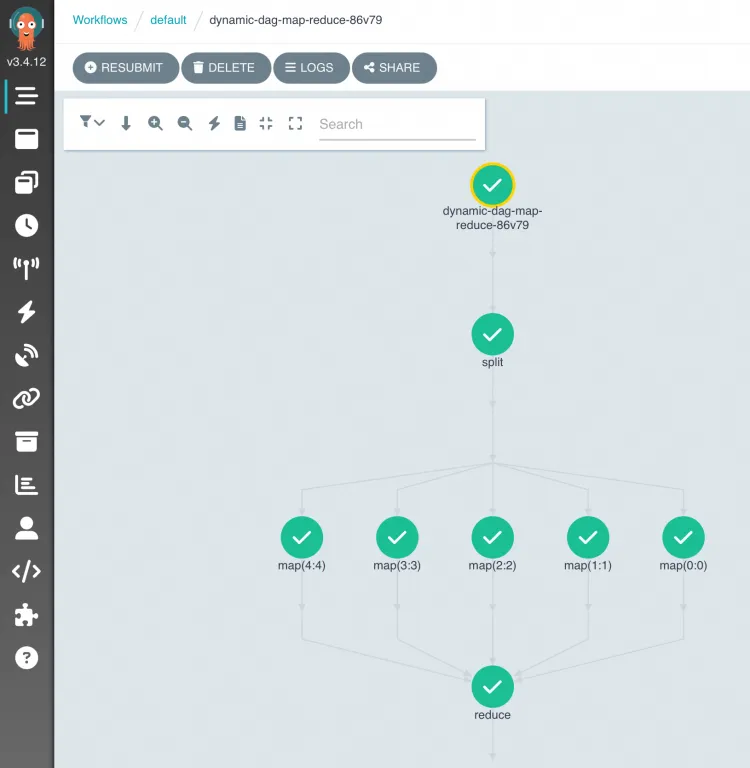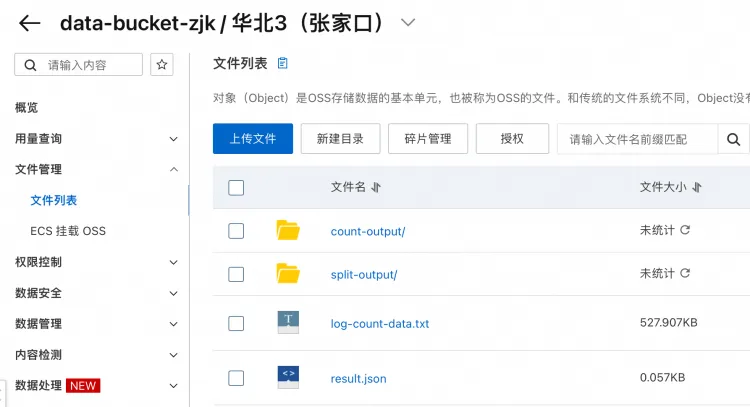在工作流编排过程中,为了加快大任务处理的速度,可以使用Fan-out Fan-in任务编排,将大任务分解成多个小任务,然后并行运行小任务,最后聚合结果。Argo Workflows支持动态DAG方式编排Fan-out Fan-in任务,可按需调度集群中的计算资源,利用ACS的弹性能力调用数万核的CPU资源,减少任务运行时间。运行结束后,资源可自动回收,节省成本。
功能介绍
在实际业务场景中,为了提升大任务的执行效率,往往需要将一个大任务拆分成数千个子任务。为了保证这数千个子任务的同时运行,需要调度数万核的CPU资源。叠加多任务需要竞争资源,一般IDC离线任务难以满足需求。
例如,在自动驾驶仿真任务场景下,修改算法后进行回归测试时需要对所有驾驶场景进行仿真,每个驾驶场景为一个子任务运行。为了提高迭代速度,所有子场景测试需要并行执行。

Fan-out和Fan-in常用于构建高效的并发处理流程,通过拆分(Fan-out)和聚合(Fan-in)操作,能够充分利用多核、多机资源,实现大规模数据的高效处理。
如上图所示,工作流编排过程中,可以使用DAG(有向无环图)编排Fan-out Fan-in任务。子任务的拆分方式分为有静态(静态DAG)和动态(动态DAG)。
静态DAG:拆分的子任务分类是固定的。例如,在数据收集场景中,同时收集数据库1和数据库2中的数据,最后聚合结果。
动态DAG:拆分的子任务分类是动态的,取决于前一个任务的输出结果。
如上图所示,在数据处理场景中,任务A可以扫描待处理的数据集,为每个子数据集(例如:一个子目录)启动子任务Bn处理。当所有子任务Bn运行结束后,在子任务C中聚合结果。具体启动多少个子任务B取决于任务A的输出结果,您可以在任务A中自定义子任务的拆分规则。
前提条件
已挂载阿里云OSS存储卷,以便工作流可以像操作本地文件一样操作OSS上的文件。具体操作,请参见使用存储卷。
操作步骤
本文将通过示例应用介绍具体操作流程:构建一个动态DAG Fan-out Fan-in工作流,读取阿里云OSS对象存储中的一个大日志文件,将其拆分为多个小文件(split),启动多个子任务分别计算每个小文件中的关键词数量(count),最后聚合结果(merge)。
将示例文件上传到PV对应的OSS路径下。
使用以下YAML创建一个工作流。具体操作,请参见创建工作流。
使用动态DAG方式实现Fan-out Fan-in编排任务。
大文件拆分为多个split子任务后,会在标准输出中输出一个JSON字符串,包含子任务要处理的partId,例如:
["0", "1", "2", "3", "4"]map任务使用
withParam引用split任务的输出,并解析JSON字符串获得所有{{item}},并使用每个{{item}}作为输入参数启动多个map任务。- name: map template: map arguments: parameters: - name: partId value: '{{item}}' depends: "split" withParam: '{{tasks.split.outputs.result}}'
更多定义方式,请参见开源Argo Workflow。
工作流运行后,在Argo控制台查看任务DAG流程与运行结果。

在OSS Bucket的文件列表中,查看输出文件,其中log-count-data.txt为输入日志文件,split-output、count-output为中间结果目录、result.json为最终结果文件。

示例源代码请参见argo-workflow-examples。
联系我们
若您有任何产品建议或疑问,请加入钉钉群(钉钉群号:35688562)联系我们。
- 本页导读 (0)
- 功能介绍
- 前提条件
- 操作步骤
- 联系我们

